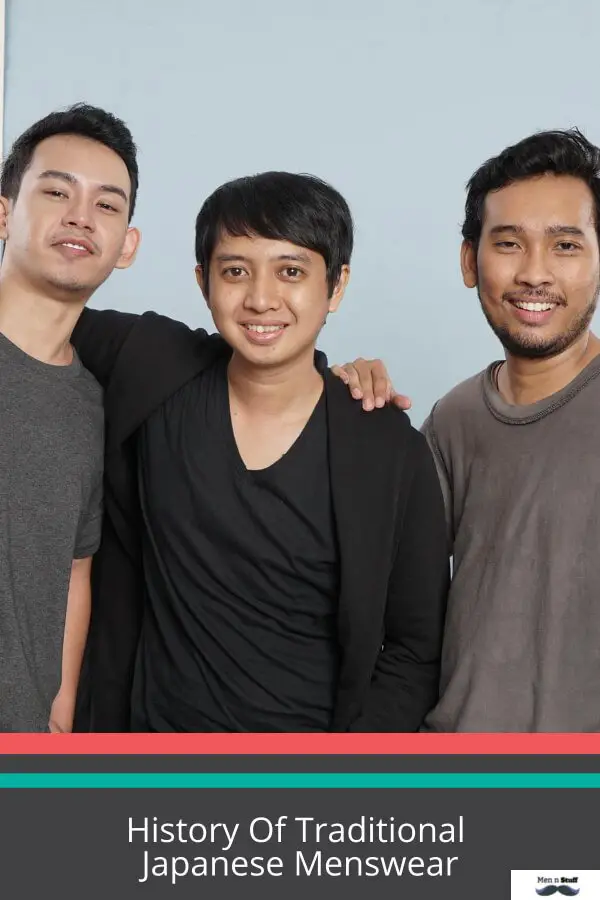Traditional Japanese menswear has a long and rich history, dating back to the ancient era. Early garments were made from simple materials like hemp and silk and were designed to be both comfortable and practical.
Overview of the History of traditional Japanese menswear
- Ancient era: Simple garments made from hemp and silk
- Heian period: Elaborate flowing robes and kimonos
- Edo period: Subdued dark colors and simpler designs
- Meiji period: Westernization and adoption of suits and ties

The History Of Traditional Japanese Menswear
The history of traditional Japanese menswear can be traced back to the ancient era when men wore simple garments made from hemp and silk. These garments were designed to be both comfortable and practical and were often decorated with simple patterns and designs.
During the Heian period (794-1185), men’s clothing became more elaborate, with flowing robes and kimonos becoming popular. The kimono, which is still worn today, is a T-shaped garment that is tied at the waist with a sash or obi. Kimonos were often made from expensive fabrics like silk and brocade and were decorated with intricate patterns and designs.
During the Edo period (1603-1868), men’s clothing became more subdued, with dark colors and simpler designs being favored. This was due to the rise of the samurai class, who emphasized simplicity and practicality in their clothing. Samurai typically wore kimonos made from dark-colored fabrics like cotton or linen and often decorated their kimonos with their family crest or kamon.
During the Meiji period (1868-1912), Japan began to Westernize, and men’s clothing began to reflect this change. Western suits and ties became popular, and are still the standard for formal wear in Japan today. However, traditional Japanese menswear is still worn on special occasions, such as weddings, funerals, and tea ceremonies.
Here is a more detailed overview of some of the most common traditional Japanese menswear items:
- Kimono: The kimono is the most iconic piece of traditional Japanese clothing. It is a T-shaped garment that is tied at the waist with a sash or obi. Kimonos can be made from a variety of fabrics, including silk, cotton, and linen. They are often decorated with intricate patterns and designs. Kimonos are typically worn for special occasions, such as weddings, funerals, and tea ceremonies.
- Hakama: The hakama is a type of wide-legged trousers that is often worn with a kimono. Hakama are made from a variety of fabrics, including cotton, linen, and wool. They are often decorated with stripes or other patterns. Hakama are typically worn by men, but they can also be worn by women on special occasions.
- Haori: The haori is a type of short jacket that is often worn over a kimono. Haori are made from a variety of fabrics, including cotton, linen, and wool. They are often decorated with patterns and designs. Haori are typically worn by men, but they can also be worn by women.
- Tabi: Tabi are split-toed socks that are worn with traditional Japanese footwear. Tabi are made from a variety of materials, including cotton, linen, and silk. They are typically white or black in color. Tabi are worn by both men and women.
- Zori: Zori are Japanese sandals that are made from wood, straw, or rubber. Zori are typically worn with tabi socks. Zori are worn by both men and women.
Traditional Japanese menswear is a rich and diverse cultural heritage. It is a beautiful and elegant form of clothing that is still worn today on special occasions.
How Kimono Is Made
The process of creating traditional Japanese menswear is called ‘shibori’. Shibori takes the fabric and folds it into a variety of patterns. The end result is gorgeous patterned fabrics that are then made up into kimono, hakama (a type of skirt), or yukata (casual summer clothes).
Shibori can be done using various methods such as tying knots in the fabric or squeezing with weights until all air bubbles out from under the cloth. This creates an intricate design on top of beautifully textured material.
Traditional Japanese menswear clothing has a long history. Kimonos have always been worn by Samurai warriors before they changed to suit western styles.
List Of Japanese Menswear Styles
Kimono Menswear Features
– sometimes traditional Japanese menswear can be an all-white wardrobe
– Kimono is the most formal of clothes in Japan and many people wear them on special occasions such as weddings or New Year
– The kimono is made up of two pieces, the top called an ‘Omoi’ and the bottom piece called a ‘Haori’. Traditionally these would have been separate garments with different fabrics. But nowadays they’re often connected to save time dressing oneself
The word Kimono may come from either the Chinese word for “clothes” (kemò) or it could refer to palace dress (ki no mono). However, some believe that this Japanese outfit has strong links to ancient Korean clothing.
Hakama Menswear Features
– A long, split skirt
– Waistband and belt loops on the front of the hakama, which are usually tied in a bow or knot to keep it closed
– Long legs for maximum protection from dirt while working outdoors. It can also be worn as an indoor formal wear piece by unbuttoning the top flap closure up until just below one’s underarm. This is called ‘Hakamashita’
– The pants have eight pleats running from their waistline down to around knee level. They’re held together at four points where they meet with themselves – two pockets that lie flat against each other on either side of the centerline seam between the right-hand pocket and the left leg of pants.
Yukata Menswear Features
1. Yukata is a traditional Japanese garment that is worn during the summer months and at festivals
2. Yukata are made from cotton, silk, or synthetic fibers
3. The sleeves of yukata can be short or long depending on the season
4. There are many different styles to choose from when purchasing a yukata
5. A wide variety of colors and patterns exist for yukatas so you can find one that suits your personality best
6. You may also want to consider wearing tabi socks with your yukata if it’s not too hot outside since they help keep your feet cool in warmer weather conditions
List Of Popular Japanese Menswear Fashion Brands
– Uniqlo (affordable price)
– Komono (simple and affordable prices, made in Japan)
– Camoshita (higher quality shoes that are handmade)
– Kottonmouth Kings (high-end designer brand for men’s clothing and accessories). Numerous stores exist all over Japan.
There are some facts about those three brands mentioned above –
1. The most popular Japanese menswear fashion brands are Uniqlo, Muji, and Comme des Garçons
2. These three brands have a wide range of products for men to choose from
3. They also offer different styles of clothing such as casual wear or formal wear
4. All three brands have stores all over the world which makes it easy to find them in your country
5. If you’re looking for something specific then these are the best places to start shopping at first
6. You can also shop online on their websites if you don’t want to go out into town
What Japanese Men Like To Wear?
Manner and etiquette are important to the Japanese, so they wear traditional clothes like kimono or yukata. Traditional menswear for formal occasions can be very beautiful with intricate patterns on silk clothing that is worn over a stiff black under-dress called an ikat which requires considerable time and skill to complete.
Traditional Japanese menswear includes different styles such as casual wear (shorts) or formal wear (a suit). Wearing Western-style clothes in Japan will not have any significance because it’s just considered normal fashion here. If you’re looking for something specific then these three brands are the best places to start shopping at first: Uniqlo, Muji, Comme des Garçons. You will find plenty of trendy clothing and menswear at these brands.
References:
https://www.britannica.com/topic/dress-clothing/Japan
https://japanjunky.com/the-history-of-traditional-japanese-clothing/

